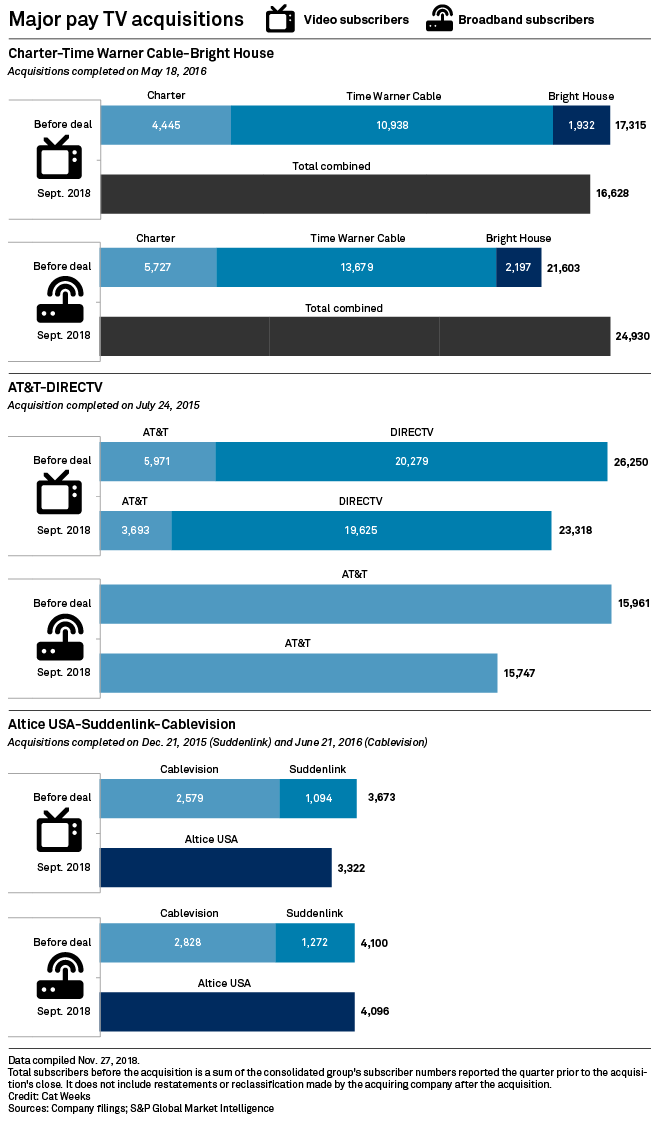The year 2019 promises to bring big changes for several of the biggest pay TV providers in the U.S., especially those that participated in the wave of M&A that swept over the industry in the last few years.
During that wave, the U.S. pay TV market saw a number of multibillion-dollar deals, including Charter Communications Inc.'s combination with Time Warner Cable Inc. and Bright House Networks LLC, Altice USA Inc.'s roll up of Suddenlink Communications and Cablevision Systems Corp., and AT&T Inc.'s acquisition of DIRECTV Group Holdings LLC. All of these companies stand ready to enter a new phase in 2019 as they continue to transform themselves to compete in a changing video market.
 2019 Outlook: | |
NAB CEO not expecting passage of major broadcast legislation in 2019 NAB CEO expects Next Gen TV in stores before next Olympics Part 1: Analysts expect changes in 2019 as Charter's M&A integration winds down |
Altice USA
Altice USA was born from its European parent Altice Europe and established itself in the U.S. through back-to-back acquisitions of Suddenlink in 2015 and Cablevision in 2016. The purchases enabled the company to quickly become one of the top-five largest cable operators in the U.S.
In the years since the acquisitions, Altice USA has continued to break out the financial performance of the two systems under the Suddenlink and Optimum brands. At the same time, however, the parent company was integrating the two operations to cut costs and achieve maximum synergies — a process that Altice USA CEO Dexter Goei said this month is now winding down.
"Listen, 2018 was really a completion of the integration process," Goei said at a Dec. 4 investor event, explaining that the company had spent the year delivering on promises to reduce operating expenses and optimize capital expenditures.
With the integration largely done, Goei said Altice USA can now focus on new growth initiatives, such as the planned launch of a mobile service in 2019 through the company's mobile virtual network operator agreement with Sprint Corp.
"We're setting ourselves up for a really, really good 2019," he said.
Altice USA recently reorganized its capital structure to operate as a more unified company. Specifically, it combined its Suddenlink and Cablevision businesses under a single credit silo.
Altice USA Co-President and CFO Charles Stewart said during a November earnings conference call that the move gives debt investors a more diversified cash flow profile, but also noted the value of "managing Altice USA as a unified company with a common strategy."
Yet Altice USA's step-by-step integration process has not gone off entirely without a hitch. This year, the company found itself the target of a lawsuit from the Dolan family, which owned Cablevision prior to its sale to Altice in 2016.
In the suit, the Dolans claim that Altice USA contractually promised to maintain staffing levels at News 12, a former Cablevision business segment that operates a group of local news television channels. Altice purportedly agreed to incur cumulative losses of up to $60 million in the operation of News 12 to maintain the network's existing employee base through 2020.
The Dolans say Altice reneged on that promise and is making job cuts. Altice has refuted the claims, saying the company "remains committed to offering meaningful news coverage" through its News 12 team.
Joe Aberger, executive vice president of the business management consulting firm Pritchett LP, said these kinds of disputes can be quite common after a deal closes.
"The problem is that executives can set expectations like, 'We're going to leave you alone,' and then two years later they start integrating and then people cry foul when their expectations are violated," Aberger said.
AT&T
When AT&T acquired DIRECTV in 2015, the satellite business was adding domestic video subscribers, and AT&T executives were excited about its possibilities for growth. But starting in 2017, DIRECTV began shedding domestic satellite customers, and the losses have only steepened over time. For the most recently ended quarter, DIRECTV lost a record 359,000 subscribers.
All told, as of the third quarter of 2018, DIRECTV and AT&T's U-verse video product have lost 2.9 million video customers as compared to the quarter prior to the AT&T/DIRECTV deal's close in 2015.
In part, the most recent losses are due to the end of a two-year price lock promotion for DIRECTV, which is resulting in higher prices for consumers. AT&T Communications CEO John Donovan said during AT&T's earnings conference call that the end of this promotional pricing will lead to ARPU growth and "significant margin relief through 2019."
But MoffettNathanson analyst Craig Moffett said AT&T appears to be prioritizing cash flow over subscriber retention in a bid to pay off its heavy debt load. On top of its 2015 DIRECTV purchase, AT&T also bought Time Warner Inc. earlier this year, resulting in total debt for the combined company of more than $183.50 billion as of the end of the third quarter.
Tony Lenoir — an analyst with Kagan, a research group within S&P Global Market Intelligence — said AT&T's purchase of Time Warner could signify where operators might pursue deals going forward.
"I would say that more consolidation — notably vertical integration as there aren't very many prized multichannel targets left — is probably in the cards," he said.
Moffett, though, is more bearish on further vertical M&A.
"I suspect we'll go through a couple of years of digestion before we see another round of deals, and it could be even longer than that," Moffett said in an interview, noting that questions about the regulatory environment and rising interest rates create overhangs.
"But the biggest questions are strategic. People want to wait to see how the last round of deals works out," Moffett said. "There's no urgency to copycat big transactions like AT&T's. The fundamental assumptions that triggered the transactions are in doubt, and the debt loads that many of the companies assumed now look rather uncomfortable."




